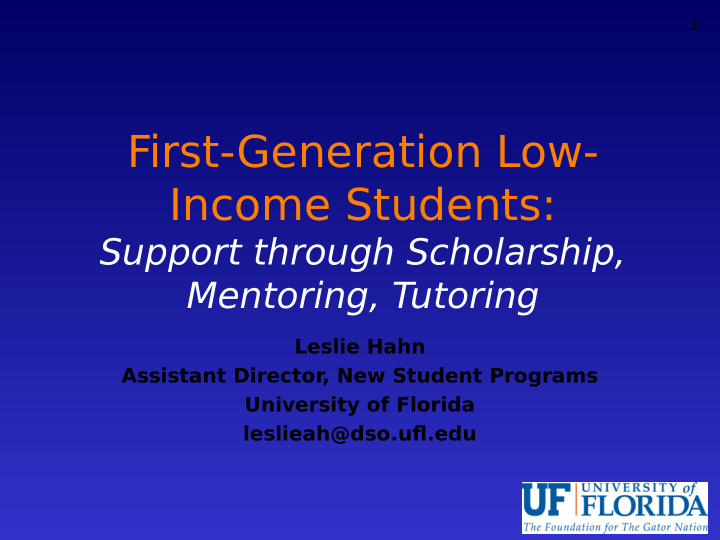



1 First-Generation Low- Income Students: Support through Scholarship, Mentoring, Tutoring Leslie Hahn Assistant Director , New Student Programs University of Florida leslieah@dso.ufm.edu
2 Presentation Overview • First-Generation and Low-Income: Who are these students? • Florida Opportunity Scholars Program (FOS) • How can you improve services to FOS-like students on your campus?
3 1. Academic preparation & “college knowledge” • FG does not always equal LI and vice versa • Many attended low income high schools • Cultural Capital (Lundberg, 2007) & College Knowledge (Vargas, 2004) – Baseball analogy • Importance of relationships with adults Lundberg, C. (2007). How bad is a dented bat? A bleacher-seat view of cultural capital. About Campus . 11(6), 8-12. Vargas, J. H. (2004). College knowledge: Addressing information barriers to college. Boston, MA: College Access Services: The Education Resources Institute (TERI). www.teri.org
2. Relationship with 4 friends and family often change • Straddling two cultures (London, 1992) – Families unsure how to support student during college – Many have friends who do not go to college – Especially tough for students living at home – Confmict management London, Howard B. (1992). T ransformations: Cultural challenges faced by fjrst- generation students. New Directions for Community Colleges, vol. 2, no. 4, p. 5-11
5 3. Free or low-cost support services often unknown or not used • Could not afgord it previously • Not part of culture • Brittany’s Story • Examples may include: Tutoring, Counseling Center, Health Clinic, Offjce Hours, etc
4. Face Difgerent 6 Pressures • Financial pressure – Working while in school – Career that makes a lot of money – Send money home to help family • Family pressure – Limit campus involvement; focus on grades – T o come home – Joselene’s story
5. T remendous drive, 7 motivation, determination • T railblazer • In college to better family situation, clear goals • Family often very proud • Many mentors • Sees college as a great opportunity, not a necessary step
8 Florida Opportunity Scholars Program University of Florida
9 Challenge • Low SES students under- represented at UF • Meeting college costs is major family concern – Fear of debt – Fear that work may negatively impact academic success
Freshmen Family 10 Income
11 Action • Create a scholarship program that provides a commitment for the lowest income students that they can graduate UF without debt and without working.
T arget Scholarship 12 Population • First-generation freshmen beginning with Summer 2006 class • Parental income < $40,000 • Florida resident
Percentage 13 Distribution by Race 2006 FTIC freshman enrollment
Projected Program 14 Costs • First year: $2.1 million – 444 students • Second year: $3.6 million – 750 students • Third year: $5.5 million – 1025 students • Fourth year: $8 million – 1250 students
Program Features 15 • Four year renewable scholarship to meet full fjnancial need (after all federal, state, institutional, private grants/scholarships) • 2.0 GPA and 24 earned credits required to renew • Support services • Funding for one study abroad opportunity
Support Services 16 • Special hour-long orientation* • Residence hall housing priority • Peer mentoring program* • Presidential reception • First-generation support groups • List serve • First-Year Florida Course* • Financial literacy workshops* • Academic interventions as necessary • Year-end celebration *Mandatory for 2007 class
Research and 17 Assessment • Most of information about fjrst cohort (now sophomores) • Three Focus Groups ( n = 22) – Surprised by lack of “requirements”/wanted more – Financial literacy sessions extremely helpful – Mentoring, wanted more contact/become mentors themselves – Understanding difgerence between HS and College took a long time – Sophomore Year: more workshops ($, Career, Study Abroad) – Send newsletter to parents • Pre T est with second cohort ( n = 190, online survey) – 77% Agreed or SA they have enough fjnancial support to attend UF – 89% Agreed or SA in their ability to succeed academically at UF – 76% listed a parent or guardian as a support system while 52% listed an FOS mentor
18 First-Year GPA Results 2006 FTIC freshman enrollment
19 Where Do We Go From Here? • Strategic Plan/Assessments • Funding – Legislative appropriations – Fundraising – Grants • Services for upper division students • Expand eligibility? • Staffjng • Review eligibility criteria
Small Group 20 Discussion Does a similar program exist on your campus? If not, would one like this be feasible? Where would you start? How are fjrst-generation, low-income students supported on your campus? What are some fjrst steps you might be able to take at your university?
21 Additional Resources Fitzgerald, B.K. (2003). The opportunity for a college education: Real promise or hollow rhetoric? About Campus , 8(5), 3-10. McCaroon, G.P & Inkelas, K.K. (2006). The gap between educational aspirations and attainment for fjrst-generation college students and the role of parental involvement. Journal of College Student Development , 47(5), 534-548. Oldfjeld, K. (2007). Welcoming fjrst-generation poor and working-class students to college. About Campus , 11(6), 2-12 Pascarella, E.T., et. al. (2004). First-Generation college students: Additional evidence on college experiences and outcomes. Journal of Higher Education , 75(3), 249-284.
22 For Additional Information: Leslie Hahn Karen Fooks New Student Programs Student Financial Afgairs leslieah@dso.ufm.edu kfooks@ufm.edu Thanks for Attending!
Recommend
More recommend